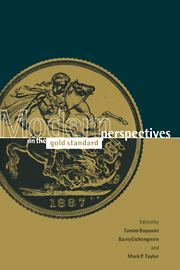Book contents
- Frontmatter
- Contents
- List of figures
- List of tables
- Notes on the contributors
- I Introduction
- II Operation of the gold standard
- III Adjustment mechanisms
- 6 The stability of the gold standard and the evolution of the international monetary fund system
- 7 International adjustments under the Classical gold standard: evidence for the United States and Britain, 1879–1914
- 8 Balance of payments adjustment under the gold standard policies: Canada and Australia compared
- IV Monetary issues
- V Exchange rate behavior
- VI Conclusions
- Index
6 - The stability of the gold standard and the evolution of the international monetary fund system
Published online by Cambridge University Press: 05 November 2011
- Frontmatter
- Contents
- List of figures
- List of tables
- Notes on the contributors
- I Introduction
- II Operation of the gold standard
- III Adjustment mechanisms
- 6 The stability of the gold standard and the evolution of the international monetary fund system
- 7 International adjustments under the Classical gold standard: evidence for the United States and Britain, 1879–1914
- 8 Balance of payments adjustment under the gold standard policies: Canada and Australia compared
- IV Monetary issues
- V Exchange rate behavior
- VI Conclusions
- Index
Summary
Introduction
Despite the attention lavished on it by generations of scholars, the question of why the pre-1914 gold standard operated so smoothly for so long remains stubbornly unresolved. Under the gold standard, the exchange rates of the major industrial countries were firmly pegged within narrow bands (“the gold points”) in an environment free of significant restrictions on international flows of financial capital. This is precisely the sort of international monetary arrangement that recent experience suggests should be fragile, precarious and difficult to maintain. The breakdown of the Bretton Woods System following the liberalization of international capital markets in the 1960s and the collapse of the narrow-band European Monetary System (EMS) on the heels of the removal of Europe's residual capital controls in the 1980s illustrate the point. How the pre-1914 gold standard managed to avoid the same fate constitutes an analytical mystery and an important policy question.
The literature on this subject can be separated into two strands concerned with the policy regime and with the structure of markets, respectively. The former focuses on the stabilizing nature of the policy rules followed by central banks and governments during the gold standard years. Eichengreen (1992), for example, focuses on credibility and cooperation as the dual pillars of the policy regime. At the core of the system – in Britain, France and Germany – there was no doubt, barring the most exceptional circumstances, that whatever steps were needed would be taken to defend the central bank's gold reserves and the exchange rate peg.
- Type
- Chapter
- Information
- Modern Perspectives on the Gold Standard , pp. 165 - 188Publisher: Cambridge University PressPrint publication year: 1997
- 2
- Cited by



